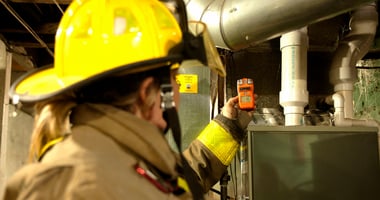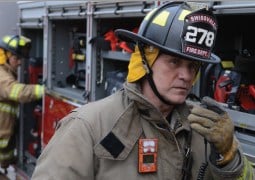How should you handle dangerous levels of carbon monoxide? Do you call the fire department or someone else? These are important questions to know the answer to. This post will discuss who to call in these situations, what EMS teams or the fire department can do and more.
How Could EMS or the Fire Department Miss Dangerous Levels of Carbon Monoxide?
Let’s take a look at how an EMS or fire response team might handle dangerous levels of carbon monoxide. An EMS team, dispatched from a major metropolitan fire department, rushes to a local hotel where they find a woman nauseated, weak, and unable to get out of bed. The evidence leads to a straightforward diagnosis: it’s flu season, it’s been a bad year for the bug, and the woman seems to have all the symptoms. Bingo. They load her onto a stretcher and transport her to the hospital.
Before the day is over, the fire station receives an alarming phone call from the hospital: the woman does not have the flu after all. Rather, it’s carbon monoxide poisoning. Immediately, firemen are dispatched back to the hotel, this time to evacuate the building. Upon arrival, responders begin searching rooms, looking for those who might be incapacitated from breathing dangerous levels of carbon monoxide. Lawsuits soon follow.
If you’re interested in learning more about this tragic episode, talk to retired Fire Captain Joe Buckley. He served as a firefighter in the Pittsburgh area for twenty-five years, and having met fellow firefighters all over the nation, he’s heard this kind of story numerous times. Each story differs in the details, but the key facts remain the same —well-meaning but ill-equipped EMS personnel fail to recognize carbon monoxide poisoning because the symptoms are so similar to common afflictions like the flu or food poisoning.
Having retired from firefighting, Buckley believes, based on years of experience, that any EMS personnel entering a structure ought to be equipped with a portable carbon monoxide (CO) monitor. The detector is a critical diagnostic tool that helps first responders understand what’s really going on in their environment.
Consider the EMS team responding to the woman in the hotel. As can happen to any of us, they succumbed to tunnel vision. They were convinced the data was pointing to a compelling and simple conclusion: this woman has the flu. Imagine, though, if the team had been equipped with a compact CO detector. It would have alarmed as soon as the team entered the building, alerting them to dangerous levels of CO. They would have known immediately that everyone in the hotel was in danger and would have evacuated the building.
Carbon monoxide is an insidious toxin that seems tailor-made to fool the unsuspecting. It’s invisible and odorless, so it’s impossible to detect without specialized equipment. CO poisoning is easily mistaken for the flu because they share many of the same symptoms, including nausea, malaise, headache, and fatigue. And the risk of CO poisoning is greatest during the cold months of flu season. When temperatures drop, people fire up furnaces and kerosene heaters — both sources of CO leaks when defective or improperly ventilated.
Even worse, the remedy for the flu can be fatal if a person is actually suffering from CO poisoning. For the flu, it’s best to stay at home and rest. But if CO is present, immediate evacuation is the proper response. Tragically, it’s not uncommon for victims of CO poisoning to be sent back home to rest— right back to the toxic environment that sent them to the hospital in the first place. 1
How Does the Fire Department Check for Carbon Monoxide?
Here’s the good news. A fireman doesn’t have to carry around bulky air-sampling equipment to monitor the environment inside a structure. Industrial Scientific’s handheld gas detectors are user-friendly and small enough to be worn as a standard part of a responder’s turnout gear. An audible alarm will sound when dangerous levels of CO are detected so there’s no question about what to do next.
These compact detectors are highly configurable and can monitor up to five gases simultaneously if desired. In addition to CO, a fire department might elect to install additional sensors to alert them to other common hazards such as hydrogen sulfide (H2S), hydrogen cyanide (HCN), and low levels of oxygen (O2).
With colder weather on the horizon, cases of the flu and CO poisoning will rise. This is the perfect time to explore Industrial Scientific’s full line of gas detection solutions for fire and emergency response teams.
1 “Carbon-Monoxide Poisoning can Mimic Flu Symptoms,” from Consumer Reports News: January 07, 2010.
FAQs about Carbon Monoxide
Who do I call for carbon monoxide?
If you suspect a carbon monoxide leak or if your carbon monoxide detector is sounding an alarm, you should immediately call 911 or your local emergency services. It's important to evacuate the area and ensure everyone is safe before trying to determine the source of the leak.
Does the fire department charge to check for carbon monoxide?
In most areas, the fire department does not charge to respond to carbon monoxide alarms or to check for the presence of CO in a residence. However, policies can vary depending on the jurisdiction or specific fire department. It's always a good idea to contact your local fire department for specifics on their policies.
Can the fire department check for carbon monoxide?
Yes, the fire department can check for carbon monoxide. If you suspect the presence of carbon monoxide in your home or building, it's essential to act quickly. Evacuate the area, ensure everyone's safety, and call your local emergency services or fire department.
1 “Carbon-Monoxide Poisoning can Mimic Flu Symptoms,” from Consumer Reports News: January 07, 2010.



